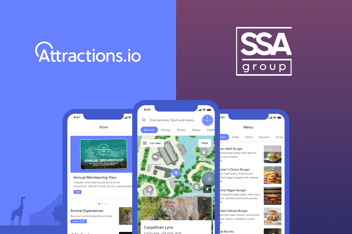It’s an exciting time for the culinary world in the cultural attraction space. Things are changing. And that’s a good thing.
As cultural attraction dining has experienced an expansive evolution the past 10 years, it’s about to move another notch towards the future. Visitors are more unique today than ever and their experience should fit that uniqueness. Diverse menu planning is becoming more of a priority.
And with this increasing emphasis on diverse dietary needs, preferences, and restrictions, innovating the menu at your cultural attraction is an opportunity to make your patron’s experience that much better. We sat down with our Corporate Executive Chef Jake Crabtree and District Chef Matthew Beaudin, to discuss how a diverse menu can be inclusive from every angle and delicious down to the very last ingredient.
Here are their top three rules for developing a diverse menu to help create an inclusive environment for all guests visiting your establishment and how you can implement the same at your own location.
1. Know your guests.
Today’s families and independent adults are more conscious of what they’re eating than ever before. They check the ingredients in the food they buy and they make sure there are options for a variety of diets when planning outings around meals.
Because of this, your menus aren’t just an ‘add-on’ to your guest experience but a major feature to motivate guests to visit and what makes them continue to return. Take the time to research your audience based on geographical location and cultural trends. Using existing dining data (from hamburger bun inventory to guest feedback on Yelp to a resource like Datassential for market-specific data) will also help you make sure your menu is a consistent and accurate reflection of the guests who visit your attraction.
From gluten-free craft beer options to locally-grown salads, there are a variety of ways to appease your guest’s diets while also appealing to local trends and making each meal enjoyable along the way.
“The key to adjusting to customers’ dietary needs versus restrictions is to have fun with it. Pull flavors, textures and think outside the box. The last thing a vegetarian, pescatarian, or vegan wants is the same old boring afterthought veggie patty. We utilize our culinary toolbox to incorporate global influences to entice all diners across the dietary spectrum,” said Crabtree.
2. Inclusivity doesn’t mean sacrificing quality.
With minimal options, it used to be that someone with a food sensitivity or specific dietary restriction had a really difficult time going out to eat regardless of the restaurant or establishment. In today’s world, the standard cafeteria-style boxed meals and snack-bar fare no longer flies. Today, our chefs work to find both quality and inclusive ingredients across the spectrum of diets so whether guests are eating hand-dipped chicken tenders or a vegan salad, it’s fresh, delicious, and sustainable.
“Our first step is always ingredients: where we’re getting them, how we’re sourcing them. In most places in the dining world, there’s usually a purchasing department, and chefs report to them. The unique thing for SSA is our purchasing reports to our chefs. This allows for our chefs to source for local and fresh ingredients and not be confined by the products a procurement department offers,” explained Beaudin.
At SSA, we also believe it’s not just about accommodating those guests who require these adaptations in the menu, but also communicating to the larger park-going public that the future of food is inclusive and eating out can be an enjoyable experience for everyone.
3. Plan with flexibility in mind.
Working on a super local and sustainable level to be more inclusive is not without its occasional difficulties. With supply chain shortages and other ingredient hold-ups, chefs need to be prepared to find other solutions to help maintain the level of quality and diversity guests have come to expect when visiting cultural attractions. Creativity and communication are key here whether it’s coming up with menu items on the fly or relaying in advance that your establishment is running low on specific ingredients.
“An important part of our culinary process is flexibility, creativity, and resourcefulness to find variety and flavor even through dietary restrictions and supply shortages. Our order pick-up service style allows for much more flexibility than traditional cafeteria formats. We also use seasonality or menu specials to provide unique dining experiences for our guests that can work with ingredient availability and culinary trends,” said Crabtree.
The future of inclusive dining.
Reaching beyond standard offerings will not only enhance the dining experience for your guests but also boost revenue, reputation, and loyalty long term for your culinary attraction. Developing a custom menu with more diverse ingredients is an experience that benefits everyone.
Curious about refining your menu to incorporate dietary needs, preferences, and restrictions? Learn more about our culinary services and how you can build a more diverse dining experience at your zoo, aquarium, or museum here.



